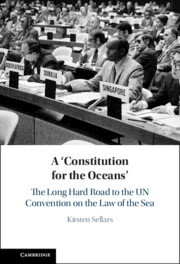Book contents
- A ‘Constitution for the Oceans’
- A ‘Constitution for the Oceans’
- Copyright page
- Contents
- Foreword
- Abbreviations
- 1 End of the Old Order
- 2 Old Freedoms, New Rights
- 3 North, South, East and West
- 4 A Conference Collapses
- 5 Internationalising the Seabed
- 6 Passage through Straits
- 7 The Archipelagic Concept
- 8 New International Orders
- 9 The Bitter End
- Afterword
- Bibliography
- Index
4 - A Conference Collapses
No Settlement on the Territorial Sea or Fishing Limits in 1960
Published online by Cambridge University Press: 06 February 2025
- A ‘Constitution for the Oceans’
- A ‘Constitution for the Oceans’
- Copyright page
- Contents
- Foreword
- Abbreviations
- 1 End of the Old Order
- 2 Old Freedoms, New Rights
- 3 North, South, East and West
- 4 A Conference Collapses
- 5 Internationalising the Seabed
- 6 Passage through Straits
- 7 The Archipelagic Concept
- 8 New International Orders
- 9 The Bitter End
- Afterword
- Bibliography
- Index
Summary
The 1958 and 1960 United Nations conferences were of a piece, with the second convened to settle the unresolved questions from the first: the breadth of the territorial sea and fishing limits. At the earlier conference, the maritime powers had been preoccupied with disputes among themselves, but by 1960 they were forced to meet the challenges presented by states from the global South. Delegates from the latter took the view that the old maritime system upheld a discredited imperialist order, and they sought to bend the law of the sea to their own ends. Their campaigns to regulate the passage of warships through the territorial sea and to claim exclusive fishing zones and preferential fishing rights gave rise to disagreements with the powers, who sought to maximise the scope of their own naval and fishing operations. These differences would lead to the breakdown of the conference.
Keywords
- Type
- Chapter
- Information
- A ‘Constitution for the Oceans' , pp. 107 - 136Publisher: Cambridge University PressPrint publication year: 2025

